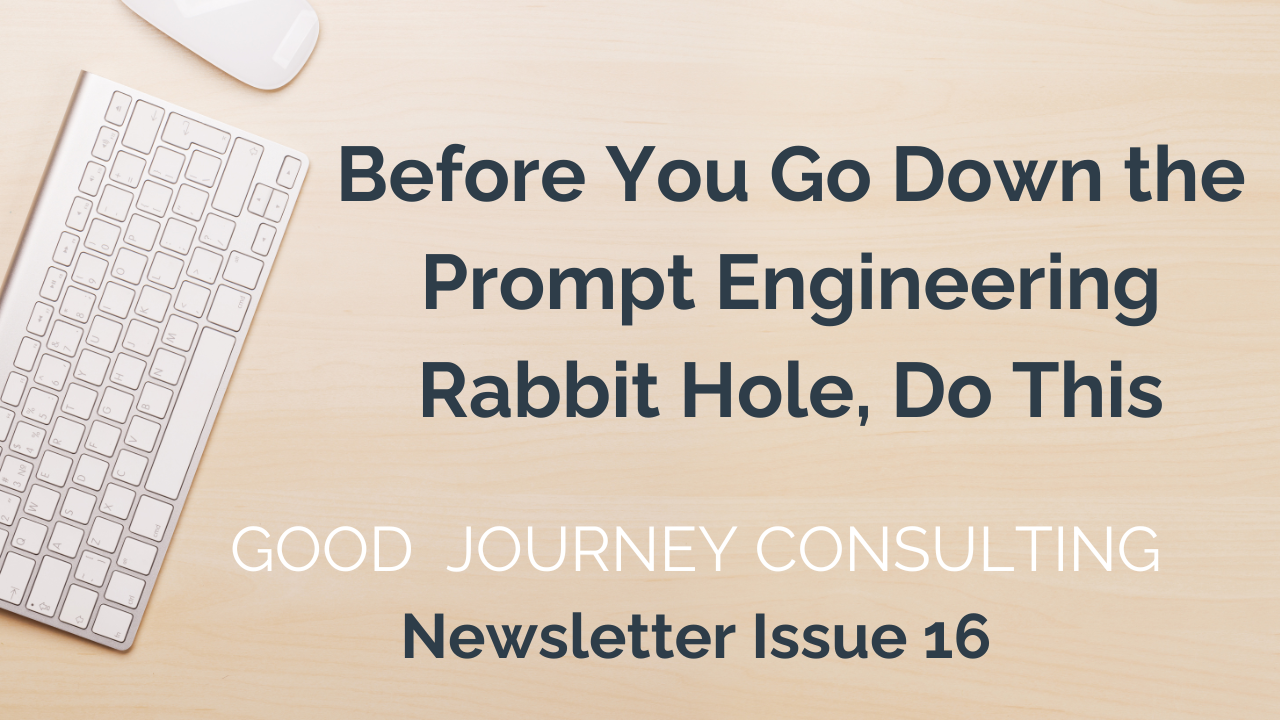Before you go down the prompt engineering rabbit hole, do this

Issue 16
Prompt engineering is an alluring idea – if you learn how to better craft the prompts you put into an AI chatbot, you should receive better output. Many lawyers who embrace AI will likely find it worthwhile to invest some time into improving their legal prompt engineering skills at some point. However, I fear that many lawyers are jumping on the prompt engineering bandwagon before it is the right time for them to do so.
Last year, Clio reported in its Legal Trends Report that the top three AI solutions being adopted in the legal industry are:
- General-purpose AI tools like ChatGPT;
- Legal research tools; and
- Document drafting tools. [i]
I am not convinced that these solutions are being adopted at the highest rates because they are necessarily the best options available to lawyers. Instead, my hunch is that a large number of the lawyers using these solutions are not yet aware of how many other, potentially better, options are available to them.
If you are new to this newsletter, you may not have learned yet that there are over 50 ways lawyers can use AI with AI tools developed for the legal industry. To date, I have added over 150 AI tools developed for the legal industry to the AI Tools directory in A Lawyer’s Practical Guide to AI. And some of these tools do not even require prompting, let alone prompt engineering.
The significant interest in legal prompt engineering among lawyers suggests to me that many lawyers see room for improvement in the output of the AI tools they are utilizing. However, learning legal prompt engineering is not a small task for most lawyers. It will likely require hours of your time, practice, and iteration. If you are considering learning legal prompt engineering, you may wish to attempt to quantify how much or what type of improvement would make the investment of your time and effort worthwhile.
Do this before you go down the prompt engineering rabbit hole
Before you go too far down the legal prompt engineering rabbit hole, I encourage you to ask yourself, would my time be better spent right now improving my legal prompt engineering skills, or ensuring that I have identified the most impactful way to use AI in my practice?
If you want to use your time to make sure you have identified the most impactful way to use AI in your practice, then here is an overview of what you can do:
Your first step should be ensuring that you have developed your AI competency. Lawyers should develop AI competency before they use AI for legal purposes in order to reduce their risk of costly and embarrassing AI-related mishaps. Further, your understanding of your professional responsibilities in relation to AI will ultimately help inform your AI tool selection.
If you have developed your AI competency, then your next step will be to gather data from your organization to quantify the area(s) where a new technology solution would make the greatest impact before you commit to any particular type of solution. Through this work, you can uncover and better understand the inefficiencies present in your organization, while taking into account your organization’s culture in relation to technology adoption and use.
Once you understand the problems where a technology solution could be most transformative, the next step is to identify the potential solutions. Keep in mind that due to the unique characteristics of your organization, the best solution for your organization may be radically different from the best solution for your biggest competitor.
Once you have a list of potential solutions, the next steps are to perform risk assessments and evaluate which tool(s) will be the best fit for your organization.
And yes, these steps will certainly take hours of your time, too. But they will be hours you can feel confident will be well spent developing your AI competency and making informed decisions in relation to your investments of time and money in new technology.
If you would like a resource that can guide you through these steps faster, from developing your AI competency to implementing the AI tool that best matches what your organization needs, you’ll want access to A Lawyer’s Practical Guide to AI. You can get instant access to the guide here.
Thanks for being here.
Jennifer Ballard
Good Journey Consulting
_______________________________________
[i] Legal Trends Report at p. 32, Clio (2024) https://www.clio.com/wp-content/uploads/2024/10/2024-Legal-Trends-Report-Full-Publication.pdf.
Stay connected with news and updates!
Join our mailing list to receive the latest legal industry AI news and updates.
Don't worry, your information will not be shared.
We will not sell your information.

